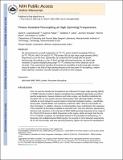Proton Assisted Recoupling at High Spinning Frequencies
Author(s)
Struppe, Jochem; Maas, Werner; Griffin, Robert Guy; Lewandowski, Jozef R.; Eddy, Matthew Thomas; Paepe, Gael De; ... Show more Show less
DownloadGriffin_Proton assisted.pdf (2.637Mb)
PUBLISHER_POLICY
Publisher Policy
Article is made available in accordance with the publisher's policy and may be subject to US copyright law. Please refer to the publisher's site for terms of use.
Terms of use
Metadata
Show full item recordAbstract
We demonstrate the successful application of [superscript 13]C−[superscript 13]C proton assisted recoupling (PAR) on [U−[superscript 13]C,[superscript 15]N] N-f-MLF-OH and [U−13C,15N] protein GB1 at high magic angle spinning (MAS) frequencies (ω[subscript r]/2π = 65 kHz). Specifically, by combining PAR mixing with low power heteronuclear decoupling (ω[subscript 1H]/2π~16 kHz) and high spinning frequencies, we obtain high resolution 2D spectra displaying long-range [superscript 13]C−[superscript 13]C contacts from which distance estimates can be extracted. These experiments therefore demonstrate the possibility of performing high resolution structural studies in the limit of high spinning frequency and low power [superscript 1]H decoupling, a regime which optimizes the resolution of protein samples and preserves their integrity.
Date issued
2009-06Department
Massachusetts Institute of Technology. Department of Chemistry; Francis Bitter Magnet Laboratory (Massachusetts Institute of Technology)Journal
Journal of Physical Chemistry B
Publisher
American Chemical Society (ACS)
Citation
Lewandowski, Jozef R., Gael De Paepe, Matthew T. Eddy, Jochem Struppe, Werner Maas, and Robert G. Griffin. “Proton Assisted Recoupling at High Spinning Frequencies.” The Journal of Physical Chemistry B 113, no. 27 (July 9, 2009): 9062-9069.
Version: Author's final manuscript
ISSN
1520-6106
1520-5207